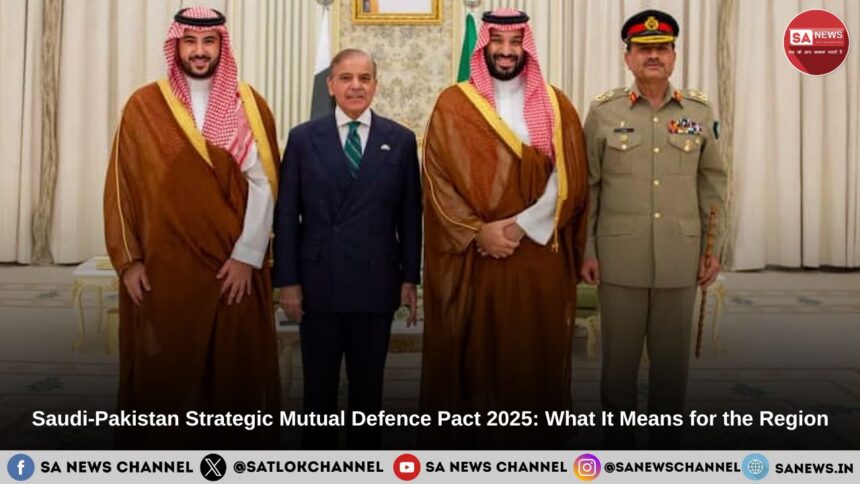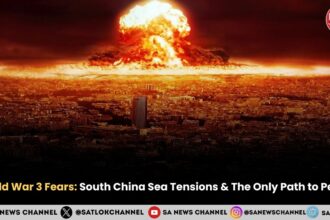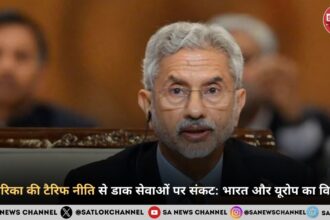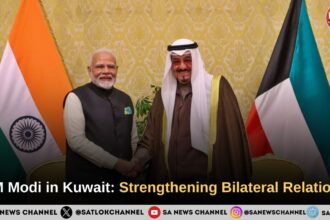On 17 September 2025, Pakistan and Saudi Arabia signed a landmark defence agreement in Riyadh called the Strategic Mutual Defense Agreement (SMDA). Under this pact, any aggression or attack on either country will be treated by the other as an attack on itself. This represents a significant deepening of their long-standing military and security ties.
The move comes amid rising regional tensions—particularly in the Gulf—and reflects shifts in alliance postures, strategic calculations, and the perception of external threats. In this article, we explore the details of the pact, its strategic implications, especially for India and the wider Middle East, and what lies ahead.
What the Pact Covers
- Mutual defence commitment: The agreement states that “any aggression against either country shall be considered an aggression against both.”
- Joint deterrence and cooperation: It aims to strengthen defence cooperation across various fields, enhancing military coordination and deterrence.
- Ambiguity over nuclear role: While Pakistan is a nuclear-armed state, the pact does not explicitly clarify whether Saudi Arabia will be formally covered under Pakistan’s nuclear ‘umbrella’. But senior Pakistani and Saudi officials have noted that the pact includes “all military means deemed necessary depending on the specific threat,” which many analysts interpret as leaving room for nuclear deterrence considerations.
- Timing & context: The agreement was signed during Pakistani Prime Minister Shehbaz Sharif’s state visit to Saudi Arabia. It follows recent regional escalations, including Israel’s airstrike in Doha, which drew widespread condemnation among Arab states.
Strategic Drivers Behind the Pact
- Perceived threats & regional instability
Recent military operations and airstrikes (notably in Qatar) have heightened anxieties among Gulf states about the unpredictability of covert and overt aggression. Saudi Arabia, in particular, is looking to reduce over-reliance on external security guarantees. - Erosion of confidence in traditional alliances
With global power shifts and questions about how far traditional allies will respond, Gulf states are seeking partnerships that offer more immediate, binding commitments. This pact signals that Saudi Arabia sees Pakistan as an essential partner in its defence strategy. - Pakistan’s role & nuclear status
For Pakistan, which has historically had close defence and political ties with Saudi Arabia (including deployment of Pakistani forces for training and protecting holy sites), this pact formalises and upgrades its security relationship. The nuclear dimension adds a deterrent factor, even if not spelled out in public documents. - Signal to Israel & others
One key function of the pact is diplomatic and strategic signalling: to Israel, and to other regional actors, that attacks similar to those in Doha will have broader consequences.
Implications for India & South Asia
For India, this new agreement introduces both challenges and areas to watch closely:
- Shifts in regional security calculus
India now faces a scenario where Pakistani aggression (or perceived aggression) might be interpreted differently by external powers. While the pact is focused on Saudi-Pakistan security, actions involving Pakistan could draw in Saudi reactions, depending on how the “attack” clause is triggered. - Diplomatic balance with Saudi Arabia
Historically, India has cultivated strong bilateral ties with Saudi Arabia—economic, cultural, energy-linked. Saudi Arabia has emphasized that this pact does not signal a rupture in its relations with India. However, there is concern in Indian strategic circles about aligning UAE / Saudi perceptions in Pakistan’s favour. - Deterrence & nuclear posture
The ambiguity around nuclear guarantees may pressure India to clarify its own posture, particularly regarding Pakistan’s potential extension of deterrence. It could also spur India to deepen ties with other Gulf states, Israel, or the US to offset perceived strategic disadvantages. - Possibility of miscalculation
Vague definitions of what constitutes an “attack” or “aggression” make room for misinterpretation. In tense border or proxy situations, incremental escalation could trigger treaty obligations.
Broader Middle East & Global Repercussions
- Rebalancing alliances
The pact signals that Saudi Arabia is diversifying its security alliances beyond the US and Western powers. Gulf states may increasingly explore similar pacts or agreements that hedge against uncertainties. - Impact on Israel-Arab relations
In light of recent conflicts and normalization efforts, this move could complicate the trajectory of normalization between Israel and Arab states. The security costs for Israel of operations in the Gulf may now be higher. - Nuclear diplomacy & non-proliferation
While the agreement does not openly declare nuclear sharing or explicit nuclear guarantees, analysts warn that the implicit strategic deterrence element could blur existing norms in the region. This has potential consequences for arms control regimes. - Great power interests
The US, China, Iran, Turkey, and Russia will all interpret this as part of the evolving security architecture in the Middle East and South Asia. For example, China may see it as aligning with its interests in a multipolar balance, whereas the US may reassess its role as guarantor of Gulf security.
Possible Scenarios Going Forward
| Scenario | What Might Happen |
| Joint reaction to aggression | If either Saudi Arabia or Pakistan is attacked (militarily or via a major cross-border strike), the other country might have treaty obligations, possibly including deployment support, intelligence sharing, and even military action. |
| Trigger of nuclear ambiguity | If threat perception crosses a red line, Pakistan might use its nuclear deterrent more overtly in defence of Saudi Arabia, depending on how “attack” is defined. |
| Domestic political impact in Pakistan & Saudi Arabia | Pakistan could face internal criticism if pulled into conflicts that strain its resources. Saudi Arabia could also have to reconcile the pact with its relations with other regional states, including India. |
| Increased diplomatic tension with Israel and India | Israeli operations or India-Pakistan tensions may now factor in Saudi responses, and India may feel pressure to strengthen its own alliances in the Gulf. |
| Risk of escalation | Misinterpretation of what constitutes aggression, especially in proxy conflicts, cyber warfare, or “lower-intensity” actions, could lead to unintended escalation. |
What is Not Clear Yet
- The precisely operational definition of “attack or aggression” under the pact: Does it include cyber attacks, terror strikes, drone-attacks, or only conventional military invasions?
- Whether Pakistan’s nuclear arsenal is formally committed to defend Saudi Arabia (i.e. a nuclear umbrella) or whether the pact remains conventional in practice.
- Mechanisms for coordination: command, rules of engagement, decision thresholds between the two countries.
- How other global actors (US, Israel, Iran) will respond in practice. Will this change diplomatic postures, missile deployments, or covert operations?
What to Watch Next
- Official clarifications from Saudi and Pakistani governments on nuclear involvement, definitions of aggression, and operational protocols.
- Indian government’s response—both at diplomatic level (with Saudi Arabia) and military/security posture changes.
- Reaction from Israel, Iran, and Gulf neighbors.
- Moves by global powers like the US, China, Russia—whether they see this as supportive or destabilising to their interests.
Why Defense Pacts Cannot Ensure True Peace
The Saudi-Pakistan defense pact highlights how nations seek security through alliances and military power. Yet, history shows that despite the strongest armies, nuclear deterrents, and global treaties, lasting peace has remained elusive. According to the divine knowledge of Sant Rampal Ji Maharaj, true safety does not lie in weapons but in the grace of the Supreme God. Sant Rampal Ji Maharaj explains through holy scriptures that only by practicing true worship of the Supreme God Kabir can humanity end fear, violence, and unrest. Where human pacts fail, God’s constitution ensures eternal peace, justice, and liberation. Thus, while countries sign agreements for survival, the ultimate solution for global harmony lies in adopting true spiritual knowledge and devotion.
FAQs on Saudi-Pakistan Strategic Mutual Defence Pact
1. What is the Saudi-Pakistan defense pact 2025?
The Saudi-Pakistan defense pact, signed in September 2025, is a Strategic Mutual Defense Agreement under which an attack on one country will be treated as an attack on both, strengthening military and security cooperation.
2. Does the Saudi-Pakistan pact include nuclear support?
The pact does not explicitly confirm nuclear sharing. However, experts suggest that Pakistan’s nuclear deterrence could implicitly extend to Saudi Arabia if needed, adding ambiguity to the agreement.
3. Why did Saudi Arabia sign a defense pact with Pakistan?
Saudi Arabia signed the pact to boost its security amid rising regional tensions, diversify its alliances, and rely on Pakistan’s strong military capabilities, including its nuclear status, for deterrence.
4. How will the Saudi-Pakistan pact affect India?
India is concerned that the pact may strengthen Pakistan’s strategic position. While Saudi Arabia insists relations with India remain strong, the agreement adds complexity to India’s regional security and diplomatic calculations.
5. What are the global implications of the Saudi-Pakistan defense pact?
The pact could reshape Middle East security, complicate Israel-Arab relations, and impact U.S., China, and Iran’s strategic interests. It may either deter conflict through stronger alliances or increase risks of escalation.









